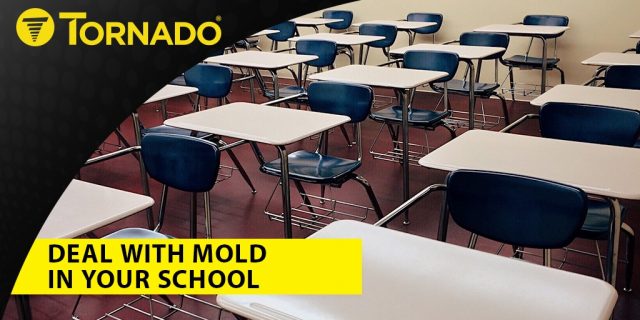Dealing With Mold In Schools
Does your school building always smell bad? Do students walk into your classroom and start sneezing on queue?
Students and teachers have heavy demands on their minds every day, yet there are added hidden forces that affect the learning process in far too many schools today. Mold may seem like a daunting foe, but there is a way to deal with mold in schools that is easy to understand and implement.
Mold Issues in Schools
Mold, found almost everywhere outdoors and indoors, can contribute significantly to poor indoor air quality (IAQ) and sick building syndrome. The problem is especially prevalent in school buildings. Nearly 20 percent of the U.S. population spend their days inside elementary and secondary schools, and estimates indicate that half of the nation’s schools have IAQ problems. In addition, mold poses costly legal and repair problems for school systems across the country. The expense to fix mold problems can be huge. School systems often have to not only worry about the expense of mold, but they must understand how mold works so that it can be treated.
Understanding Mold
To develop and grow, mold needs three things: a comfortable temperature, food, and water. Use one of these variables against mold and you can start attacking the problem. Of the three, using temperature to prevent mold in schools is the most difficult because mold flourishes in the same moderate temperature needed by students and teachers. Food is also a problem because just about all organic matter is food for mold. Thus, the strategic way to reduce mold in a school building is to minimize moisture.
Finding and Stopping Mold
As soon as mold is detected, the source of the moisture feeding it has to be found and corrected; otherwise, once it is removed the mold will simply grow back. Eliminating the source of the moisture includes fixing leaky pipes, drains, roofs, and windows as well as assuring adequate ventilation.
After finding the sources, hot-water carpet extraction can be used to attack the mold. Here are some ways to do prevent mold growth in your school:
• Use hot-water carpet extractors: the heated solution found in extractors like the Marathon Carpetrinser improves the efficiency of the cleaning chemicals and speeds up drying times
• Employ air blowers: with constant air movement, blowers (such as the Tornado Windshear® 3200) will speed up the drying process immensely
• Use dehumidifiers: these are necessary in extreme circumstances when you need to remove excess moisture
You don’t have to walk into a dank, smelly and hazardous school building anymore. Take the steps needed to improve your school’s learning environment, morale, and health by finding the mold in your building and using the proper equipment to eradicate it. Invest in the equipment needed to take your school to the next level of quality.

